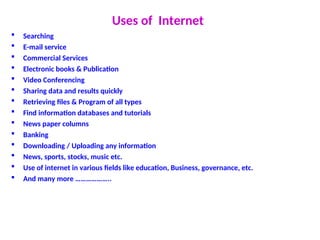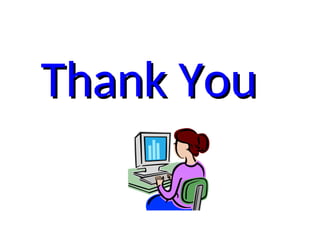Computer Fundamental and Introduction Computers
- 1. Fundamentals for Better Communication Through Computer By P. H. Prajapati Extension Education Institute AAU, Anand
- 2. What is Computer ? Computer is an electronic device. Can store large amounts of data. Can performing operations on data. Performing given function on the data & displays the result as output. Process data whenever needed. Known from ‘to compute’
- 3. What is Process? Computer works on data as per programme is called process. Processing means operations like….. Calculations, Logical decision making, Outputting data, Communicating with others computer etc.
- 4. History of Computers First(1945-1955): Used vacuum tubes. Were very large. Generated immense heat. Very expensive. Second(1955-1965): Used transistors. Continued to be large and expensive. Third(1965-1975): Used integrated circuits. Significant reduction in size and cost Fourth(1975-1995): Uses Very Large Scale Integration. Desktop computers would not have been possible without VLSI. It used Microprocessor minimizing the size of P.C. Fifth (in progress): Will provide us with Artificial intelligence. Also called knowledge information processing system
- 5. Characteristics of Computer Speed Arithmetical and Logical Operations Accuracy Reliability Storage Retrieving Data and Programme Automation Versatility (Flexible) Consistency Communications
- 7. Hardware/Software • Computer Hardware Parts of computer, which can be touch is called hardware. (Physical Parts) Monitor CPU Key Board Mouse Speaker • Computer Software Parts of computer, which can not be touch is called software. • Operating System Software : Windows, MAC, Linux • Application Software : MS Office, Photoshop, Media Player • Internet Browser Software : Internet Explorer, Google Chrome, Mozilla Firefox, etc.
- 8. Classification of Computers Personal computer : A single-user computer Can be useful at School, Home, etc. Known as Micro Computer Laptop, Desktop Workstation : A powerful, single-user computer. A workstation is like a personal computer, but it has a more powerful microprocessor higher-quality monitor. Can be found in companies etc.
- 9. Minicomputer A multi-user computer Capable of supporting from 10 to hundreds of users simultaneously. Can be found in banks, government departments etc. Mainframe A powerful multi-user computer Capable of supporting hundreds or thousands of users simultaneously. Supercomputer An extremely fast computer Can perform hundreds of millions of instructions per second Weather, scientific research can be done by these types of computer.
- 10. Applications of Computer • Science research • Education • Business applications • Banking • Office Automation • Desktop publishing • Management aids • Engineering designing • Road traffic control • Railway • Medicine • Information services
- 11. What is Internet Inter connection of many computers via network. Global connected through network (through LAN or WAN) To provide the various application services i.e. E-Mail, Usenet (News), WWW, Telnet, FTP, etc At any time millions user connected to the internet from many countries.
- 12. Uses of Internet Searching E-mail service Commercial Services Electronic books & Publication Video Conferencing Sharing data and results quickly Retrieving files & Program of all types Find information databases and tutorials News paper columns Banking Downloading / Uploading any information News, sports, stocks, music etc. Use of internet in various fields like education, Business, governance, etc. And many more ………………..
- 13. Useful Keys Internet • Network: Connecting computers with each other For exchanging information • Client : It is a programme or computer for getting special information from another compute. • Server: It is a programme or computer, which gives information to the client computer. • Protocol: It’s a rules for connecting to the internet. (TCP/IP) • Portal: It is a website. Known as a gateway of internet. (Search engine) 06/01/25 13
- 14. Router: It is a device, which decides where data will be send (Network point) www : World Wide Web Browser: It is a programme which helps us to use internet Website: Group of different web pages. URL : Universal Resource Locator
- 15. .com : Commercial organization .net : Large Networks .gov : Government organization .org : non-profit making organization .edu : educational organization .mil : military organization .in : India .au : Australia .us : United States .uk : United Kingdom Types of Website (Domain No.)















